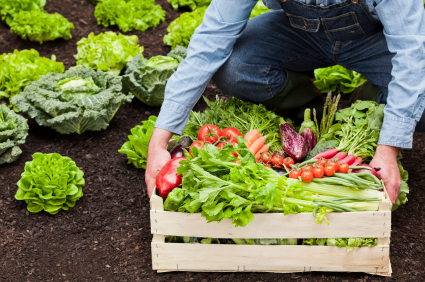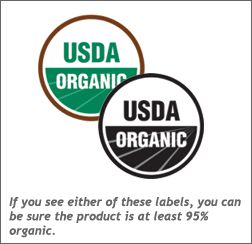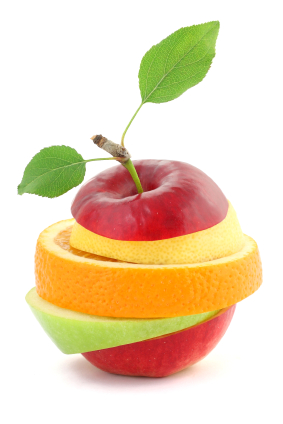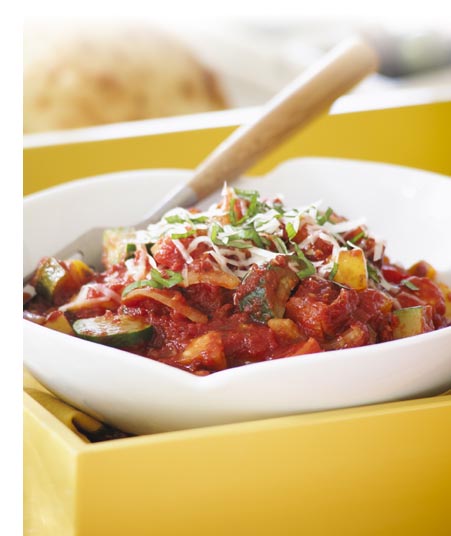To Your Health: August 2012
In this Issue:
- What Does Organic Mean?
- Organic vs Non-Organic – Myths and Facts
- Benefits of Buying Organic
- What to Buy
- News and Events
- Recipe of the Month: Slow and Easy Ratatouille
- Quote of the Month
A Note from Bonnie
Today there is an abundance of information regarding the cost benefit of organic versus conventionally grown foods. This month I will define what the word “organic” actually means, the benefits of eating organic, as well as clarify myths versus facts of organic foods and non – organic foods. You will also find two reference lists: “The Dirty Dozen Plus™” and “The Clean 15™”, that will help simplify your shopping. Finally, be sure to check out this month’s recipe “Slow and Easy Ratatouille.” This is a yummy summertime dish and if you are inspired by this month’s newsletter, head out to your local farmer’s market!
Enjoy!
—Bonnie
What Does Organic Mean?
 The USDA National Organic Program (NOP) defines organic as follows:
The USDA National Organic Program (NOP) defines organic as follows:
Organic food is produced by farmers who emphasize the use of renewable resources and the conservation of soil and water to enhance environmental quality for future generations. Organic meat, poultry, eggs, and dairy products come from animals that are given no antibiotics or growth hormones. Organic food is produced without using most conventional pesticides; fertilizers made with synthetic ingredients or sewage sludge; bioengineering; or ionizing radiation. Before a product can be labeled “organic,” a Government-approved certifier inspects the farm where the food is grown to make sure the farmer is following all the r ules necessary to meet USDA organic standards. Companies that handle or process organic food before it gets to your local supermarket or restaurant must be certified, too.
There are four categories of labels relating to the product being “organic”:
 “100% Organic” means the product contains all organic ingredients, with the exception of salt and water as these are not certifiable. These products cannot be affected by the “big three”: irradiated, contains genetically engineered organisms (GEO’s), or grown with sewage sludge fertilizer.
“100% Organic” means the product contains all organic ingredients, with the exception of salt and water as these are not certifiable. These products cannot be affected by the “big three”: irradiated, contains genetically engineered organisms (GEO’s), or grown with sewage sludge fertilizer.
If the label only says, “Organic,” 95% of the ingredients in the product are organically grown.
A label that says, “Made with Organic….,” means that 70% of the ingredients within the product are organic. The “big three” rules apply here, for the 70% organic ingredients as well as the 30% non-organic. The supplier may list up to 3 ingredients that are organic on the front of the label.
Labels that list organic ingredients on the side panel of the package contain less than 70% organic ingredients. There can be no organic claims on the front of the label. The “big three” are allowed to be in the non-organic ingredients.
Organic vs Non-Organic – Myths and Facts
Written and reproduced with permission of Robin Berlin, RD
Myth 1: Organic means healthier
Fact: There is no evidence that organic implies that the product has more nutrients than non- organic products.
Myth 2: Organic is the same as local
Fact: The organic labels describes how the product is raised or grown. Local indicates the product you are consuming was grown nearby. There is no defined distance that makes a product locally grown. Sometimes local products are grown organically, but organic does not imply local organic.
Myth 3: Organic is the same as natural
Fact: Natural is a term used only for the processing of meat and egg products. Natural implies that the product has been “minimally processed” and contains no artificial ingredients. Organic can apply to produce, grains, meat, poultry, eggs and dairy.
Don’t assume that food labeled “natural,” “sustainable,” “hormone-free,” or “free-range” is organic. The U.S. does not regulate the use of those labels, so anyone can use them.
Benefits of Buying Organic
With all the hype surrounding food production and the risks to consumers, many people are opting for all organic diets. Here are 4 benefits of buying organic foods. But remember, the decision is ultimately up to you.
- Pesticide residue on foods may cause cancer. However, keep in mind that organic foods show a lower frequency of pesticide residue, but are not guaranteed to be chemical-free.
- Organic meat is free of antibiotics and added hormones. Animals that are raised organically are not allowed to be fed antibiotics, the recombinant bovine growth hormones rbGHo or rBST.
- Most synthetic additives are forbidden in organic convenience foods. However, natural additives are still approved to be in these products. The best way to ensure additive free food is to cook with organic ingredients from scratch.
- Organic foods do not come from genetically engineered crops or animals. Genetically engineered basically means taking the gene from one species and placing it in another to increase food production. There is a problem organic farmers are having called “genetic drift.” This is when pollen from nearby GEO crops contaminate organic crops. There are discussions on ways to deal with this situation, but none have been enacted as of yet.
What to Buy?
 The Environmental Working Group (EWG), a non profit group that analyzes the results of government pesticide testing, has compiled a list of the 14 foods they recommend buying Organic – they call this list the “Dirty Dozen Plus™” as well as a list of 15 foods that have the least amount of pesticide residue, called “The Clean 15™”
The Environmental Working Group (EWG), a non profit group that analyzes the results of government pesticide testing, has compiled a list of the 14 foods they recommend buying Organic – they call this list the “Dirty Dozen Plus™” as well as a list of 15 foods that have the least amount of pesticide residue, called “The Clean 15™”
The Dirty Dozen Plus™
Apple
Celery
Sweet bell peppers
Peaches
Strawberries
Nectarines – imported
Grapes
Spinach
Lettuce
Cucumber
Blueberries – domestic
Potatoes
Plus
+ Green beans
+ Kale/Greens
for these may contain pesticide residues of special concern
The Clean 15™
Onions
Sweet Corn
Pineapples
Avocado
Cabbage
Peas
Asparagus
Mangoes
Eggplant
Kiwi
Cantaloupe – domestic
Sweet potatoes
Grapefruit
Watermelon
Mushroom
News and Events:
NEW PROGRAM!
iEat Mindfully
Make Peace with Food – Enjoy Guilt Free Eating, a Life Free of Dieting, and a Body You Love
Watch you inbox in the next few weeks for detailed information on this exciting new program that will free you from dieting and help you return to your natural healthy body weight without feeling deprived or restricted.
If you can’t wait, and want information now, email Bonnie to set up a complementary phone call to see if this program is right for you!
The Nutrition Key with BRG – Blog
Be inspired and motivated this summer as our Summer Success Stories Series continues!
If you haven’t yet signed up to follow the BRG Blog, click here now so you don’t miss out on all the great success stores. You will receive an email with the link to each new post. Sign up now!
The following success stories have already been published: Melanie, Denise, Nancy and Cassandra.
Read about Cassandra’s Success story here and get inspired!
Contest Winner: Win a Nutrition Check-up!
Congratulations to Karissa Thurau who won a Nutrition Check-up in our Facebook contest. If you haven’t LIKED us on Facebook yet, here’s the link.
Recipe of the Month: Slow and Easy Ratatouille
Reproduced with permission of www.tomatowellness.com
Prep time: 15 minutes
Cook time: 3 to 6 hours
Serves: 4
Ingredients
2 Tbsp extra virgin olive oil
1 large onion, coarsely chopped
3 cloves minced garlic
2 medium zucchini, halved and sliced
1 eggplant (about 1 ¼ lbs.), peeled and cut into 1-inch chunks
1 medium fennel bulb, quartered and thinly sliced (white base only)
1 small red pepper, seeded and diced
1 small yellow pepper, seeded and diced
1 (29-oz.) can crushed tomatoes
1 (6-oz.) can tomato paste
1 tsp each: dried basil, rosemary and thyme
1 tsp sea salt or to taste
Ground or smoked pepper to taste
Snipped fresh basil and grated Parmesan cheese (optional)
Instructions
- Heat oil in a large skillet. Add onion; cook and stir over medium high heat for 5 minutes.
- Add zucchini, eggplant and garlic; cook for 5 more minutes.
- Transfer to a slow cooker with all remaining ingredients except fresh basil and Parmesan.
- Cover and cook on HIGH for 3 hours or on LOW for 6 hours.
- Serve hot or at room temperature topped with fresh basil and Parmesan.
Quick Stovetop Variation:
- Prepare as directed above, cooking in a large pot instead of a slow cooker.
- Bring to a boil; reduce heat and simmer, covered, for 30 to 45 minutes or until vegetables are cooked to your liking.
Nutrition Facts:
Calories: 130
Fat: 4g
Saturated Fat: 0.5g
Trans Fat: 0g
Cholesterol: 0mg
Sodium: 610mg
Potassium: 926mg
Carbohydrates: 22g
Fiber: 7g
Sugar: 7g
Protein: 5g
Vitamin A: 30%
Vitamin C: 120%
Quote of the Month:
“Every second we choose to nourish ourselves in a way that supports or depletes our lives, and to think and speak about other people in a way that is honoring or dishonoring. What choice are you going to make today?”
– Gregg Braden



Leave a Reply
Want to join the discussion?Feel free to contribute!